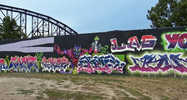
Unraveling the Art of the Streets: Exploring Different Styles of Graffiti
, by Bobby Banks, 4 min reading time

, by Bobby Banks, 4 min reading time

Graffiti, a once-underground art form, has transformed from simple tags to intricate masterpieces that grace urban landscapes across the globe. In this exploration of different graffiti styles, we discuss the evolution of this dynamic medium, highlighting various techniques such as tagging, throw-ups, wildstyle, blockbuster, stencil, and 3D graffiti. From the basic building blocks of tagging to the mind-bending illusions of 3D art, graffiti artists continue to push the boundaries of creativity, making their mark on the world and redefining the way we perceive public spaces. Graffiti, often considered an urban art form, has evolved from simple, hastily drawn tags to intricate masterpieces that adorn city walls and spaces around the world. It began as a subversive act, with artists seeking to express their ideas, identities, and emotions in a public space. Over time, graffiti has gained recognition as a legitimate art form, with numerous styles emerging to reflect the diverse creativity of its practitioners. In this article, we'll explore some of the most popular and influential graffiti styles, delving into their history, techniques, and unique characteristics.
Tagging is the most basic form of graffiti and often serves as an artist's signature. It consists of a stylized version of the artist's name or pseudonym, usually done in a single color. Tagging is the building block of graffiti and serves as an entry point for many aspiring artists. Although it may appear simple, a well-executed tag can be a testament to the artist's skill and control over their medium.
Throw-ups, or bubble letters, are a step up from tagging in terms of complexity. They involve the use of larger letters, typically outlined and filled with a single color. Throw-ups are quick to execute and are often used to cover larger areas or to establish an artist's presence in a specific location. The rounded, bubbly nature of the letters makes them easily recognizable and gives them a playful, energetic feel.
Wildstyle is one of the most intricate and complex graffiti styles, characterized by interlocking, overlapping letters, and a high degree of detail. This style emerged in the early 1980s in New York City and quickly gained popularity among graffiti artists worldwide. Wildstyle often incorporates arrows, spikes, and other elements that give the artwork a sense of movement and energy. Due to its complexity, this style can be challenging to decipher, which adds an element of intrigue and exclusivity to the art.
The blockbuster style features large, blocky letters that are easy to read and cover a wide area. Often used to dominate a space and make a bold statement, blockbuster graffiti is typically executed with rollers and paintbrushes rather than spray cans. This style is particularly effective for conveying messages or slogans and can be seen as a more accessible form of graffiti due to its readability.
Stencil graffiti is a technique that involves creating a stencil, typically from cardboard or plastic, and using it to spray paint a design onto a surface. This method allows for clean lines and precise shapes, as well as the ability to reproduce the same image multiple times with ease. Stencil graffiti gained mainstream attention through the works of artists like Banksy, whose satirical and politically charged pieces have garnered global recognition.
3D graffiti is a style that seeks to create an illusion of depth and dimensionality on a flat surface. By using techniques like shading, perspective, and trompe l'oeil, artists can make their work appear to pop off the wall or interact with the surrounding environment. This style has gained popularity in recent years, with artists pushing the boundaries of what can be achieved through the use of optical illusions and creative placement.
Graffiti is a dynamic and ever-evolving art form that has come a long way from its humble beginnings. The styles mentioned above represent just a fraction of the diverse range of techniques and approaches employed by graffiti artists worldwide. As cities continue to embrace street art and provide opportunities for artists to share their work, the public can expect to see even more innovative and captivating styles emerge in the future. Graffiti, a form of urban art, has evolved over the years and diversified into various styles, each with its unique flair and technique. This expressive art form has long been used as a way for artists to communicate their thoughts, emotions, and social commentary.
 en
en